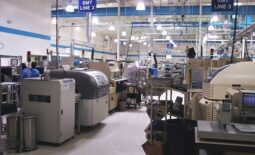Smart manufacturing in Mexico will boost economic growth
Digitization and automation are affecting all industries; more and more manufacturers in Mexico are aware of the importance of transforming their operations with the help of smart technology.
In Mexico, manufacturing accounts for approximately 25% of the country’s Gross Domestic Product (GDP). Industry has historically been the driver of economic growth in the country. Today the sector has managed to reach an important position worldwide. With smart manufacturing in Mexico beginning to take root, the nation is ready to continue to improve its productivity. New technologies will enable Mexico to evolve and sustain its global competitiveness.
For manufacturing companies in Mexico, one of the most important challenges is the integration of emerging technologies into existing operations. These include physical cyber systems; autonomous machines and systems; Internet of Things (IoT); additive manufacturing (3D printing); big data and macro data analysis; cloud computing; simulation of virtual environments; artificial intelligence; cybersecurity; and augmented reality.
Utilizing these technologies is related to the proper integration of traditional IT functions with those that are responsible for innovation in the manufacturing facility through operational technologies. These are executed in areas such as manufacturing, warehousing, logistics, among others.
Unlike the previous three industrial revolutions, the fourth industrial revolution will allow a large number of technologies to coexist and interact. This will result in the creation of a connected and interoperable ecosystem with a surprising volume of data and exponential growth in real-time connectivity. Today, smart factories in Mexico must be more connected than ever. Immediately having valuable information available to decision-makers will have a domino effect across entire organizations and will also have an effect on supplier networks. Thus, Industry 4.0 (or the fourth industrial revolution) has the potential to increase the level of productivity of manufacturing companies in Mexico, and around the world, by 50%.
Today, it is possible to connect all the actors that make up the productive structure of an organization in real-time. This enhances manufacturers’ ability to respond to important demands efficiently and effectively. For instance, at the start of the day, access to a factory that has employed smart manufacturing in Mexico can be monitored through the use of cameras that are equipped with software that makes it possible to read vehicle license plate information automatically for plant security. On the other hand, cameras that allow security staff to quickly detect suspicious people, vehicles, and other objects thanks to their horizontal, vertical, and zoom scrolling capabilities can be put to use. These features provide high-quality evidence and optimal video analysis.
On the other hand, two-way digital radio equipment, that is interconnected with high-precision sensors, receive, transmit and analyze voice and data, are able to transmit from anywhere. This includes information between different functional areas or different geographical regions.
Smart manufacturing in Mexico decentralizes decision-making
Through the data and intelligence generated by new technologies, companies that are running smart factories in Mexico can promote the decentralization of decision making and move from preventive models to predictive models that can be applied in all areas. These include the supply chain (adjusting times in the provision of inputs and minimizing the need for inventories); equipment failure detection systems (eliminating preventative stops and anticipating damage); and in the logistics system (anticipating the requirement for inputs and finished products, making distribution and delivery more efficient).
The intelligent use of information resources is also a necessity for smart factories in Mexico that is reflected in lower costs and increased productivity. With video security, license plate recognition, and telemetry applications, managers can determine which resources are needed to perform tasks more efficiently and to access the correct resources that are required to take effective action.
Each company needs to analyze and define its own goals, strengths, and weaknesses before embarking on its own path of transformation. To be sure, to boost productivity and improve competitive advantage, the next step is to understand how to manipulate a large amount of data to in order to bring about beneficial results
According to consulting firm PwC, the digitization process in the global manufacturing industry expects to reduce costs by more than $420 billion by 2025, as well as sees a potential increase in annual revenues of about $493 billion. This allows us to see that a path of constant changes, opportunities, and challenges for manufacturers continues, where the adoption of global trends in industry 4.0 will increasingly allow the digitization to increasingly consolidate in smart manufacturing in Mexico.




